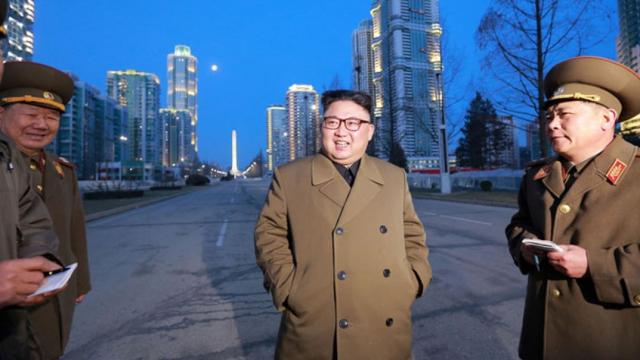
After the U.S. Navy deployed ships to the Korean Peninsula, North Korea threatened to launch nuclear weapons at the U.S. Video provided by Newsy Newslook
It isn't safe to wait until a dictator can strike America.
Imagine a world without communist North Korea. For the Trump administration, it’s easy if you try.
President Trump tweeted that Pyongyang is “looking for trouble” and that he would “solve the problem” with or without North Korea’s neighbor and patron China. This was the latest in an escalating exchange of threats in which the Kim Jong Un regime threatened nuclear retaliation if “even a single bullet” was fired at the Hermit Kingdom. Meanwhile, the USS Carl Vinson carrier strike group is headed towards the peninsula, and China has deployed 150,000 troops to the Korean border, possibly to mitigate the flood of refugees that would follow military action.
The crisis is long in coming. Successive generations of policymakers have kicked the North Korea can down the road since the 1953 armistice. The Kim dynasty was allowed to maintain its totalitarian dystopia because the threat was mostly contained, and there was no solution that did not involve a general war that would devastate our prosperous democratic ally in South Korea. Instead, the world awaited the expected collapse of the nightmarish North Korean dictatorship. The collapse has yet to come.
Now the calculus has changed. North Korea has an active nuclear weapons program and is rapidly developing the capability to deliver these weapons to the United States mainland. Kim Jong Un, the communist state’s third dynastic ruler, is determined to have a seat at the strategic nuclear table. If the United States waits, one of the most bellicose, seemingly least rational regimes in modern history will have the capability to kill millions of Americans at a stroke.
The Trump administration has reportedly been drawing up contingency plans for solving the problem before millions of American lives are at stake. National Security Adviser Lt. Gen. H.R. McMaster said Sunday that deploying forces in the region was prudent and that President Trump has asked for “a full range of options to remove that threat to the American people and to our allies and partners in the region.” The Trump administration isn't the first to consider preemptive military action against North Korea. Defense secretaries from the Obama and Clinton administrations made the case in 2006. But active counterproliferation against North Korea’s nuclear and missile programs — which is to say, destroying them — has always been risky because of the threat of millions of North Korea troops swarming south.
However, there may be a solution that at least lowers the risk. During last month’s combined exercises in South Korea, U.S. forces participated in a simulated decapitation strike to take out North Korea’s leadership. The decapitation option is attractive because all power in the totalitarian state is focused in Kim Jong Un. If he vanished, the state apparatus could well be paralyzed. North Korean generals would hesitate to take action because initiative has been bred out of the power structure; anyone with ideas and ambition has probably already been fed to the dogs.
Kim could well have sought to deter such a strike by issuing standing orders to initiate a spasmodic military strike in case of his death. But his underlings may not execute it. The model would be Adolf Hitler’s last-ditch “Nero Decree” to reduce Germany to scorched earth, which his staff chose to ignore. Senior North Korean leaders may recognize how much better life would be with the Kim regime gone; no more living under threat of being executed by anti-aircraft weapon for accidentally nodding off at a meeting, for example.
POLICING THE USA: A look at race, justice, media
The problem, of course, is how to get Kim. The dictator is highly paranoid, and for good reason, since many people are out to get him. He can employ elaborate means of avoiding detection, and went underground for more than a month in 2014. Pyongyang is honeycombed with tunnels and underground bunkers, no doubt able to sustain Kim and his core group of aides and commanders for an extended period. But the solution may come from the inside. How can Kim fully trust those around him, those most likely to be on the receiving end of his irrational impulses, made worse by being holed up? Putting his personal protective system under constant pressure — such as through threats of imminent U.S. military action, and spreading information about suspected disloyal elements in the North Korean hierarchy — could lead to an internal breakdown, or flush the quarry.
Kim may also be shamed into showing himself above ground. The dictator is overly sensitive; North Korean state media responded scathingly to John McCain’s offhand comment about Kim being a “crazy fat kid.” Kim fancies himself an evil genius, but he has only mastered the first half of that equation. The burrowing gopher may have to show himself just to prove he is the godlike hero his regime has portrayed him as. Maybe he could be goaded into making another visit to People’s Army Goat Breeding Station 621. Hopefully, when the resulting strike rains down the livestock will be spared.
James S. Robbins, a member of USA TODAY's Board of Contributors, has taught at the National Defense University and the Marine Corps University and served as a special assistant to the secretary of defense in the George W. Bush administration. He is author of This Time We Win: Revisiting the Tet Offensive.
You can read diverse opinions from our Board of Contributors and other writers on the Opinion front page, on Twitter @USATOpinion and in our daily Opinion newsletter. To submit a letter, comment or column, check our submission guidelines.
Keine Kommentare:
Kommentar veröffentlichen